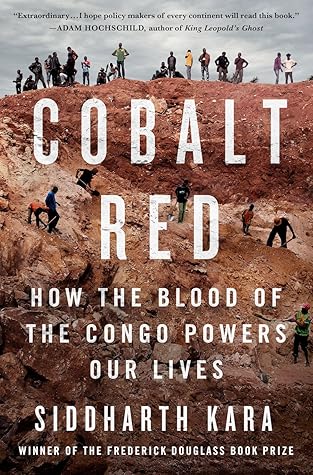More on this book
Community
Kindle Notes & Highlights
Read between
April 24, 2023 - June 15, 2024
Katanga region in the southeastern corner of the Congo holds more reserves of cobalt than the rest of the planet combined.
The harsh realities of cobalt mining in the Congo are an inconvenience to every stakeholder in the chain. No company wants to concede that the rechargeable batteries used to power smartphones, tablets, laptops, and electric vehicles contain cobalt mined by peasants and children in hazardous conditions.
In all my time in the Congo, I never saw or heard of any activities linked to either of these coalitions, let alone anything that resembled corporate commitments to international human rights standards, third-party audits, or zero-tolerance policies on forced and child labor. On the contrary, across twenty-one years of research into slavery and child labor, I have never seen more extreme predation for profit than I witnessed at the bottom of global cobalt supply chains.
daily lives are powered by a human and environmental catastrophe in the Congo.
ivory for piano keys, crucifixes, false teeth, and carvings (1880s), rubber for car and bicycle tires (1890s), palm oil for soap (1900s+), copper, tin, zinc, silver, and nickel for industrialization (1910+), diamonds and gold for riches (always), uranium for nuclear bombs (1945), tantalum and tungsten for microprocessors (2000s+), and cobalt for rechargeable batteries (2012+).
The battery packs in electric vehicles require up to ten kilograms of refined cobalt each, more than one thousand times the amount required for a smartphone battery. As a result, demand for cobalt is expected to grow by almost 500 percent from 2018 to 2050,3 and there is no known place on earth to find that amount of cobalt other than the DRC.
there is no such thing as a clean supply chain of cobalt from the Congo. All cobalt sourced from the DRC is tainted by various degrees of abuse, including slavery, child labor, forced labor, debt bondage, human trafficking, hazardous and toxic working conditions, pathetic wages, injury and death, and incalculable environmental harm.
Despite being home to trillions of dollars in untapped mineral deposits, the DRC’s entire national budget in 2021 was a scant $7.2 billion, similar to the state of Idaho, which has one-fiftieth the population. The DRC ranks 175 out of 189 on the United Nations Human Development Index. More than three-fourths of the population live below the poverty line, one-third suffer from food insecurity, life expectancy is only 60.7 years, child mortality ranks eleventh worst in the world, access to clean drinking water is only 26 percent, and electrification is only 9 percent.
most artisanal cobalt miners earn paltry incomes between one or two dollars per day.
If you really want to understand what is happening in the Congo’s mining sector, you must first understand our history. After independence, the mines were managed by the Belgians. They took all the money, and there was no benefit for the people. After the Belgians, we had “Africanization” with Mobutu. He nationalized the mines, but again, they only benefited the government, not the people. With [Joseph] Kabila, we created the Mining Code in 2002, and this brought foreign investment into the mining sector. They said the Mining Code would improve the lives of the Congolese people, but today,
...more
a child in the Congo dies every day so that they can plug in their phones.”
Time-lapse satellite images of Kolwezi from 2012 to 2022 show that the “brown” around the city spread like a tsunami, devouring everything in its path.
There is grief, and then there is soul-wrenching misery. There is loss, and then there is life-destroying calamity.


